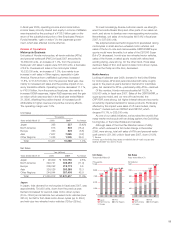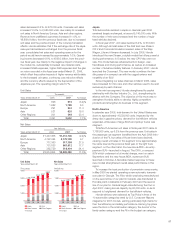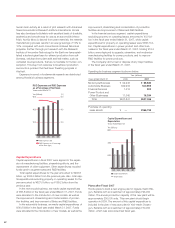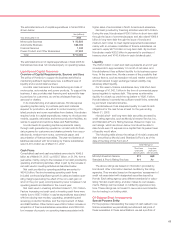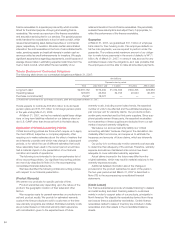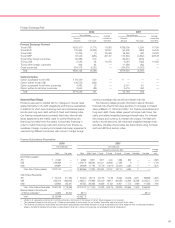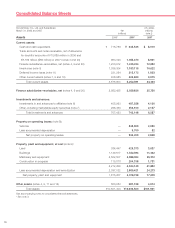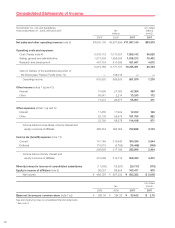Honda 2007 Annual Report Download - page 65
Download and view the complete annual report
Please find page 65 of the 2007 Honda annual report below. You can navigate through the pages in the report by either clicking on the pages listed below, or by using the keyword search tool below to find specific information within the annual report.
63
The estimated amount of capital expenditures in fiscal 2008 is
shown below.
Yen (millions)
Year ending March 31 2008
Motorcycle Business ¥092,800
Automobile Business 588,000
Financial Services 1,300
Power Product and Other Businesses 27,900
Total ¥710,000
The estimated amount of capital expenditures in fiscal 2008 for
financial services does not include property on operating leases.
Liquidity and Capital Resources
Overview of Capital Requirements, Sources and Uses
The policy of Honda is to support its business activities by
maintaining sufficient capital resources, a sufficient level of
liquidity and a sound balance sheet.
Honda’s main business is the manufacturing and sale of
motorcycles, automobiles and power products. To support this
business, it also provides retail financing and automobile leas-
ing services for customers, as well as wholesale financing
services for dealers.
In its manufacturing and sales business, Honda requires
operating capital mainly to purchase parts and materials
required for production, as well as to control inventory of fin-
ished products and cover receivables from dealers. Honda also
requires funds for capital expenditures, mainly to introduce new
models, upgrade, rationalize and renew production facilities, as
well as to expand and reinforce Sales and R&D facilities.
Honda meets its operating capital requirements mainly
through cash generated by operations. Honda funds its finan-
cial programs for customers and dealers primarily from corpo-
rate bonds, medium-term notes, commercial paper, and
securitization of finance receivables. The year-end balance of
liabilities associated with fund-raising by finance subsidiaries
was ¥4,470.4 billion as of March 31, 2007.
Cash Flows
Consolidated cash and cash equivalents amounted to ¥945.5
billion as of March 31, 2007, up ¥228.7 billion, or 31.9%, from a
year earlier, mainly owing to the increases in net cash provided by
operating and financing activities, offset in part by the increase in
net cash used in investing activities as described below.
Net cash provided by operating activities amounted to
¥904.5 billion. Factors increasing operating cash flows
included continued significant growth in sales and stable oper-
ating margins (excluding the effect of the non-cash gain on
return in the prior year), accompanied by lower increases in net
operating assets and liabilities in the current year.
Net cash used in investing activities totaled ¥1,130.7 billion.
Factors increasing net cash used in investing cash flows were
mainly due to ¥597.9 billion in capital expenditures associated
with introducing new models, upgrading, streamlining and
renewing production facilities, and the improvement of Sales
and R&D facilities. Other factors were ¥240.2 billion increase in
acquisition of finance subsidiaries-receivables and ¥365.5 bil-
lion increase of property on operating leases associated with
higher sales of automobiles in North America and elsewhere.
Net cash provided by financing activities was ¥423.4 billion.
During the year, Honda raised ¥306.0 billion in short-term debt
through the issue of commercial paper, and also raised ¥969.4
billion in long-term debt through the issue of bonds and
medium-term notes to meet capital requirements associated
mainly with an increase in liabilities of finance subsidiaries, as
well as to repay ¥677.5 billion in long-term debt. By contrast,
Honda also made ¥26.6 billion in payments for purchase of
treasury stock and ¥140.4 billion in cash dividends paid.
Liquidity
The ¥945.5 billion in cash and cash equivalents at end of year
corresponds to approximately 1.0 month of net sales, and
Honda believes it has sufficient liquidity for its business opera-
tions. At the same time, Honda is aware of the possibility that
various factors, such as recession-induced market contraction
and financial and foreign exchange market volatility, may
adversely affect liquidity.
For this reason, finance subsidiaries carry total short-term
borrowings of ¥1,842.1 billion in the form of commercial paper
issued regularly to replace debt. This serves as alternative
liquidity for a back-up credit line equivalent to ¥826.1 billion.
Honda believes it currently has sufficient credit limits, extended
by prominent international banks.
Honda believes it has adequate liquidity to meet its cash
obligations for the near future at least for the year ending
March 31, 2008.
Honda’s short- and long-term debt securities are rated by
credit rating agencies, such as Moody’s Investor Service, Inc.,
and Standard & Poor’s Rating Services. Based on major cur-
rent ratings, which are shown below, Honda will be able to
raise funds even if it requires more capital than its present level
of liquidity would allow.
The following table shows the ratings of Honda’s unsecured
debt securities by Moody’s and Standard & Poor’s as of the
date of the filing of this Form 20-F.
Credit Ratings for
Short-term Long-term
unsecured unsecured
debt securities debt securities
Moody’s Investors Service P-1 Aa3
Standard & Poor’s Rating Services A-1 A+
The above ratings are based on information provided by
Honda and other information deemed credible by the rating
agencies. They are also based on the agencies’ assessment of
credit risk associated with designated securities issued by
Honda. Each rating agency uses different standards for calcu-
lating Honda’s credit rating, and also makes its own assess-
ments. Ratings can be revised or nullified by agencies at any
time. These ratings are not meant to serve as a recommenda-
tion for trading in or holding debt.
Off-Balance Sheet Arrangements
Special Purpose Entity
For the purpose of accelerating the receipt of cash related to our
finance receivables, we periodically securitize and sell pools of
these receivables. In these securitizations, we sell a portfolio of




